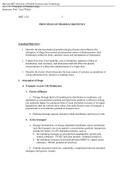Class notes
22 Principles of Pharmacology - Principles of Pharmacokinetics
- Course
- Institution
The object of the course is to teach students an approach to the study of pharmacologic agents. It is not intended to be a review of the pharmacopoeia. The focus is on the basic principles of biophysics, biochemistry, and physiology as to the mechanisms of drug action, biodistribution and metabolis...
[Show more]



